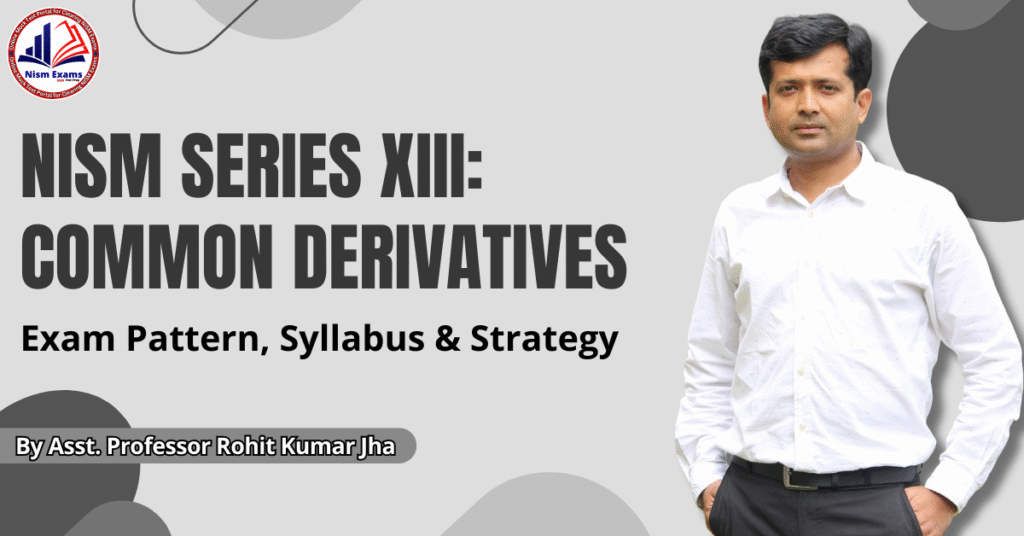In my 25 years as an educator in the financial markets, I have had the privilege of speaking with thousands of retail investors. I have seen their portfolios grow, their confidence build, and their understanding of the equity market deepen. Yet, there is one word that almost always elicits a reaction of fear, confusion, or outright dismissal: derivatives. For many, the Futures and Options (F&O) market is a “no-go” zone, a complex world of speculation best left to the big players.
While it is true that trading derivatives involves significant risk and is not suitable for everyone, I am here to argue that understanding them is no longer optional for any serious investor in India. You do not need to trade a single contract to benefit from the immense knowledge the derivatives market provides. Think of it as the market’s secret language. The “smart money”—the large institutions, the foreign investors, and the professional traders—are constantly communicating their expectations through derivatives. Learning to decipher these signals is like gaining a superpower for your own equity investing.
In this guide, I want to demystify this topic for you, the retail investor. We will strip away the jargon and focus on how understanding the basics of derivatives can make you a smarter, more informed, and more risk-aware participant in the cash market. For those whose interest is piqued enough to consider a career in this field, the journey to mastery is a structured one, often beginning with a quality NISM 13 Mock Test.
1. What Are Derivatives, Stripped of Jargon?
At its core, a derivative is simply a financial contract whose value is derived from an underlying asset. For our discussion, the underlying asset is typically a stock (like Reliance) or an index (like the Nifty 50). The two most common types are:
- Futures: Think of this like a coupon to buy milk. You agree on a price today (say, ₹55 per litre) to buy milk one month from now. If the price of milk in the market goes up to ₹60 next month, your coupon is valuable. If the price falls to ₹50, your coupon is worthless. A futures contract is a standardised agreement to buy or sell an asset at a predetermined price on a future date.
- Options: Think of this as buying an insurance policy. A put option is like insurance against a price fall. You pay a small premium, and if the price of your asset falls below a certain level, the option pays you back, protecting you from losses. A call option is a bet on a price rise.
2. Why You, a Cash Market Investor, Should Care
Okay, so you understand the basics. But you are a long-term investor who buys and holds stocks. Why should you care about what traders are doing in the F&O market? Because their collective actions create powerful, real-time indicators that you can use to your advantage.
Signal #1: Derivatives as a Leading Indicator of Market Sentiment
The derivatives market often acts as a leading indicator, signalling a potential change in market mood before it is fully reflected in the cash market prices. Two key indicators to watch are:
H3: The Put-Call Ratio (PCR)
The PCR is a simple ratio of the total number of put options traded versus call options.
- A high PCR (above 1): This means more people are buying puts (insurance against a fall) than calls (bets on a rise). It signals fear or a bearish sentiment.
- A low PCR (below 0.7): This means more people are buying calls. It signals greed or a bullish sentiment.
By tracking the PCR on a daily basis, you can get a real-time pulse of the market’s mood.
H3: The India VIX (The “Fear Index”)
The India VIX is an even more direct measure of fear. It is calculated from the prices of Nifty options and represents the market’s expectation of volatility over the next 30 days.
- A rising VIX: Signals increasing fear and uncertainty. A VIX above 20 is often a sign of significant nervousness.
- A low VIX: Signals a sense of calm and stability.
Signal #2: Derivatives Reveal the ‘Smart Money’s’ Footprints
The derivatives market is dominated by large, informed players. Their actions, which are often for hedging large portfolios, can give you clues about their expectations. One way to track this is by looking at Open Interest (OI). OI is the total number of outstanding futures or options contracts.
A significant build-up of OI at a particular strike price can indicate that a large number of participants believe that level will act as a strong support or resistance for the market. A professional preparing for their certification with a NISM Common Derivative Mock Test would be tested extensively on interpreting these data points.
3. A Real-World Example: Reading the Signals Before a Big Event
Let’s see how a regular investor can use this knowledge to make a smarter decision.
The Setup: An Investor’s Dilemma Before the Union Budget
Meet Arjun, a 40-year-old professional who has a portfolio of blue-chip stocks worth ₹20 Lakhs. It is the last week of January, and the Union Budget is just a few days away. The market is choppy, and Arjun is feeling nervous. He has some extra cash and is thinking of investing it, but he is also worried about a potential post-Budget market crash.
The Derivative Market’s Clues
Instead of just relying on TV news, Arjun decides to look at the derivative market’s signals:
- He checks the India VIX. He notices that the VIX, which was hovering around a calm 14 a few weeks ago, has steadily climbed to 21.
- He checks the Put-Call Ratio. He sees that the PCR for the Nifty has risen to 1.3, indicating that for every 10 call options being traded, 13 put options are being traded.
The Informed Decision
Arjun, by understanding these signals, can now make a much more informed decision.
- His Interpretation: The rising VIX and high PCR are clear signs that the “smart money” is nervous. Large investors are actively buying put options to insure their portfolios against a potential negative surprise in the Budget. This doesn’t guarantee that the market will fall, but it does guarantee that the market is expecting high volatility.
- His Action: Based on this, Arjun decides on a prudent course of action. He decides not to deploy his extra cash before the Budget. He also decides to hold off on trimming his existing portfolio, knowing that the high VIX might be a sign of peak fear. He has not traded a single derivative, but he has used the information from the derivatives market to make a wise, risk-managed decision for his cash portfolio.
This is the power of understanding the market’s secret language. This is a skill that is honed through deep study, and for those who wish to make it their profession, through rigorous practice with a quality NISM XIII Practice Test.
4. The Professional’s Path: From Understanding to Expertise
This guide is intended to give you, the investor, a powerful new lens through which to view the market. It is about empowering you to make more informed decisions. However, for some, this can be the spark that ignites a deeper interest.
The world of derivatives is a challenging and incredibly rewarding career path. The professionals who operate in this space—the traders, the risk managers, the corporate treasurers—are some of the most sought-after in the entire financial industry. Their expertise is built on a deep, foundational, and certified knowledge of these complex instruments.
For those whose curiosity is sparked and who wish to pursue a professional career in this field, a formal, regulator-approved certification is essential. The NISM Series XIII is the most comprehensive starting point, and you can explore the concepts further with a NISM Series XIII: Common Derivative Certification Mock Test. This allows you to get a real feel for the depth of knowledge required to move from being an informed observer to a competent professional. A good NISM 13 Model Test will cover all the concepts discussed here and more.
5. Conclusion: Becoming a More Intelligent Investor
You do not need to be a derivatives trader to benefit from the derivatives market. By learning to read the simple signals it provides—the whispers of fear from the VIX, the tug-of-war in the PCR—you can add a powerful new dimension to your own investment analysis.
It is a tool that can help you protect your capital, manage your emotions, and make more rational, informed decisions. It is a step towards becoming a more complete, more intelligent, and ultimately, a more successful investor.
Frequently Asked Questions (FAQs)
1. Is this article advising me to start trading in Futures and Options?
No, absolutely not. The article’s core message is that every cash market investor should understand the basics of derivatives, not necessarily trade them. The goal is to use the information and signals from the derivatives market to make smarter, more informed decisions for your own stock and mutual fund portfolio.
2. What is the simplest way to understand Futures and Options?
The blog uses simple analogies:
- Futures: Like a coupon to buy something (e.g., milk) at a pre-agreed price in the future.
- Options: Like an insurance policy. A put option is insurance against a price fall, and a call option is a bet on a price rise.
3. What is the India VIX, and what does a high VIX mean?
The India VIX is the Volatility Index, often called the “Fear Index.” The article explains that a high or rising VIX signals that fear and uncertainty are increasing in the market. It indicates that large investors are actively buying options to protect their portfolios from expected high volatility.
4. What is the Put-Call Ratio (PCR), and how can I use it as an investor?
The Put-Call Ratio is the ratio of total put options traded versus call options. A high PCR (above 1) signals a fearful or bearish sentiment, while a low PCR (below 0.7) signals a greedy or bullish sentiment. As an investor, you can use it as a real-time gauge of the market’s mood to decide whether to be aggressive or defensive with your own investments.
5. In the real-world example, did the investor Arjun trade any derivatives?
No. This is a key point of the article. Arjun, the investor, did not trade a single derivative contract. He simply used the signals from the derivatives market (the high VIX and high PCR) to make a more informed and prudent decision for his cash portfolio, which was to hold off on investing new money before a volatile event.
6. Why is the derivatives market called a “leading indicator”?
It is often called a leading indicator because the “smart money” (large, informed institutions) uses the derivatives market to place their bets and hedge their portfolios before major events or market moves. Their collective actions, visible through indicators like the VIX and PCR, can therefore signal a potential change in market direction before it becomes apparent in the cash market.
7. If I want to make a career in this field, what is the recommended first step?
The article recommends that the first step for an aspiring professional is to gain a formal, structured, and regulator-approved qualification. The NISM Series XIII: Common Derivatives Certification is highlighted as the most comprehensive starting point as it covers Equity, Currency, and Interest Rate derivatives.
8. How can a NISM 13 Practice Test help a professional aspirant?
A NISM XIII Practice Test helps by bridging the gap between theory and practice. The blog explains that the scenario-based questions in a good mock test force the candidate to apply their knowledge of concepts like VIX and PCR to real-world market situations, which is a critical skill for any derivatives professional.
9. Are derivatives only used in the stock market?
No. While the article uses the stock market as its primary example, it mentions that the professional NISM XIII certification also covers Currency Derivatives (for forex markets) and Interest Rate Derivatives (for bond markets), highlighting the broad applicability of these instruments.
10. What is the key takeaway of this guide for a regular retail investor?
The key takeaway is that you should not ignore the derivatives market just because you don’t trade in it. By learning to read its simple, powerful signals, you can gain a valuable analytical edge, better understand market risk, and ultimately become a more intelligent and successful long-term investor. A good first step to understand these concepts in more detail is by trying a NISM XIII Demo Test.




